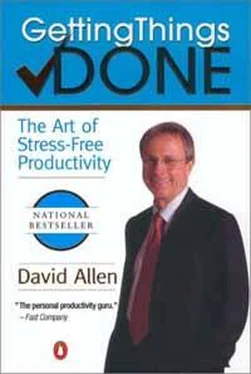Get High-Quality Mechanics File cabinets are not the place to skimp on quality. Nothing is worse than trying to open a heavy file drawer and hearing that awful screech! that happens when you wrestle with the roller bearings on one of those $29.95 "special sale" cabinets. You really need a file cabinet whose drawer, even when it's three-quarters full, will glide open and click shut with the smoothness and solidity of a door on a German car. I'm not kidding.
Get Rid of Hanging Files If You Can At the risk of seriously offending a lot of people who are already using hanging files, I recommend that you totally do away with the hanging-file hard-ware and use just plain folders standing up by themselves in the file drawer, held up by the movable metal plate in the back. Hanging folders are much less efficient because of the effort it takes to make a new file ad hoc and the formality that imposes on the filing system.
Here's an e-mail I received recently from a senior manager who actually took my advice after avoiding it for a couple of years because of his investment in the hanging hardware:
Your system is FANTASTIC!! I've completely redone my files at home and at work — it only took a combined four days to do it, but I've done away with Pendaflex and have gone to the manila folder system, with A-Z and nothing else. WOW! It's so much easier. My desk for some reason is a lot neater, too, without those stacks of "to be filed" stuff hanging around!
But If You Can't . . . Many people are stuck with the hanging-file system, at least at work, because side-opening hanging-folder filing cabinets have become standard corporate issue. If you have to work with hanging files, then I recommend that you:
• Label the files, not the hangers. That lets you carry the file folders for meetings and when traveling, without taking the hanger.
In the fire zone of real work, if it takes longer than sixty seconds to file something, you won't file, you'll stack.
• Use only one file folder per hanger. This will keep the drawer visually neat and prevent the weirdness that results when multiple files make a hanger uneven. Having to recalibrate files in an alpha system every time a folder gets full is too much trouble.
• Keep a big supply of plain hangers and new file folders in the front of your first file drawer so you can make new files and store them in a flash.
Purge Your Files at Least Once a Year Cleaning house in your files regularly keeps them from going stale and seeming like a black hole, and it also gives you the freedom to keep anything on a whim "in case you might need it." You know everything will be reassessed within a few months anyway, and you can redecide then what's worth keeping and what isn't. As I say, I purge my files while I'm on hold on the phone (or marking time on a conference call that's dragging on and on!).
I recommend that all organizations (if they don't have one already) establish a Dumpster Day, when all employees get to come to work in sneakers and jeans, put their phones on do-not-disturb, and get current with all their stored stuff. [5] A great time to do this is Christmas Eve Day, or some similar near-holiday that falls on a workday. Most people are in "party mode" anyway, so it's an ideal opportunity to get funky and clean house.
Dumpsters are brought in, and everyone has permission to spend the whole day in purge mode. A personal Dumpster Day is an ideal thing to put into your tickler file, either during the holidays, at year's end, or around early-spring tax-preparation time, when you might want to tie it in with archiving the previous year's financial files.
One Final Thing to Prepare . . .
You've blocked off some time, you've gotten a work area set up, and you've got the basic tools to start implementing the methodology. Now what?
If you've decided to commit a certain amount of time to set ting up your workflow system, there's one more thing that you'll need to do to make it maximally effective: you must clear the decks of any other commitments for the duration of the session.
If there's someone you absolutely need to call, or something your secretary has to handle for you or you have to check with your spouse about, do it now. Or make an agreement with your self about when you will do it, and then put some reminder of that where you won't miss it. It's critical that your full psychic attention be available for the work at hand.
Almost without exception, when I sit down to begin coaching people, even though they've blocked out time and committed significant money to utilize me as a resource for that time, they still have things they're going to have to do before we quit for the day, and they haven't arranged for them yet in their own systems. "Oh, yeah, I've got to call this client back sometime today," they'll say, or "I have to check in with my spouse to see if he's gotten the tickets for tonight." It bespeaks a certain lack of awareness and maturity in our culture, I think, that so many sophisticated people are ignoring those levels of responsibility to their own psyche, on an ongoing operational basis.
So have you handled all that? Good. Now it's time to gather representatives of all of your open loops into one place.
5. Collection: Corralling Your "Stuff"
IN CHAPTER 2 I described the basic procedures for collecting your work. This chapter will lead you in more detail through the process of getting all your incompletes, all your "stuff," into one place—into "in." That's the critical first step in getting to the state of "mind like water." Just gathering a few more things than you currently have will probably create a positive feeling for you. But if you can hang in there and really do the whole collection process, 100 percent, it will change your experience dramatically and give you an important new reference point for being on top of your work.
When I coach a client through this process, the collection phase usually takes between one and six hours, though it did take all of twenty hours with one person (finally I told him, "You get the idea"). It can take longer than you think if you are committed to a full-blown capture that will include everything at work and everywhere else. That means going through every storage area and every nook and cranny in every location, including cars, boats, and other homes, if you have them.
Be assured that if you give yourself at least a couple of hours to tackle this part, you can grab the major portion of things out-standing. And you can even capture the rest by creating relevant placeholding notes—for example, "Purge and process boat storage shed" and "Deal with hall closet."
In the real world, you probably won't be able to keep your stuff 100 percent collected all of the time. If you're like most people, you'll move too fast and be engaged in too many things during the course of a week to get all your ideas and commitments captured outside your head. But it should become an ideal standard that keeps you motivated to consistently "clean house" of all the things about your work and life that have your attention.
Ready, Set. . .
There are very practical reasons to gather everything before you start processing it:
1. it's helpful to have a sense of the volume of stuff you have to deal with;
2. it lets you know where the "end of the tunnel" is; and
3. when you're processing and organizing, you don't want to be distracted psychologically by an amorphous mass of stuff that might still be "somewhere." Once you have all the things that require your attention gathered in one place, you'll automatically be operating from a state of enhanced focus and control.
Читать дальше











